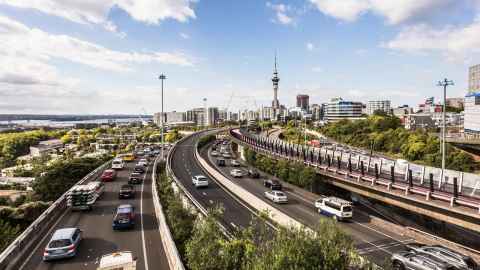Sensible solutions for Auckland's transport woes
6 July 2021
Opinion: A number of problems with Auckland’s infrastructure have become starkly apparent in recent times, writes Professor David Grinlinton.

Transport networks are under stress and failing. Water provision, stormwater and waste disposal are also under stress through years of neglect. This reflects a rapidly increasing population, even though there has been an even more rapidly increasing rates take by a supposedly ‘more efficient’ super-city.
The Ardern government had promised to spend big on infrastructure development, but little has been delivered upon yet. Whatever eventuates, it is important that these plans deliver sensible long-term solutions that are economically and environmentally sustainable, rather than short-term ‘feel-good’ projects driven by political expediency and narrow ideological interests.
Whatever eventuates, it is important that these plans deliver sensible long-term solutions that are economically and environmentally sustainable, rather than short-term ‘feel-good’ projects driven by political expediency and narrow ideological interests.
Road networks will continue to be critical, even with the transition away from fossil fuels. Electric cars and buses, and hydrogen-powered trucks, will still require roads, and many New Zealanders will continue to prefer personal autonomy over public transport for various reasons.
Public transport is simply not feasible for many people. Mass public transport will not reach every corner of the city, nor cater for the majority of unique transport requirements. Freight and commercial goods movement will continue to be reliant on trucking for the foreseeable future. It is surely better to provide an efficient workable roading network that mitigates the immense economic and environmental costs created by mounting congestion and traffic jams.
A related issue is the link to the Airport and light rail. This is a classic example of trying to address multiple problems with one imperfect solution. Yes – light-rail has great potential serving the more densely populated suburbs. Provided they are reliable, sufficiently regular, and not outrageously expensive to build and operate, they would be an asset. But trying to use this option to also service the airport isn’t sensible. Consider the patronage.
Exhausted international travellers who may have already spent many hours, and in some cases days, travelling from far-flung corners of the globe will not be attracted by a slow, crammed, uncomfortable, ‘stops at all stations’ tram to get into the city; they will take a cab.
There is already an existing electrified rail link passing not far from the Airport on the main trunk line. Given the anticipated growth of Auckland, an additional loop to the Airport from Puhinui would provide a fast and comfortable electrified ‘Airporter’ train with just a few stops – a much more practical, desirable and sustainable long-term option.
Finally, a second harbour crossing is urgently needed. As demonstrated last year with the chaos following a traffic accident that damaged the Harbour Bridge structure, and regular gridlock when there are other accidents or events, a second crossing is well overdue.
As demonstrated last year with the chaos following a traffic accident that damaged the Harbour Bridge structure, and regular gridlock when there are other accidents or events, a second crossing is well overdue.
Twin tunnels - such as we now have at Waterview - seem the most reliable and environmentally friendly option, and it is good to see that this is the thinking of the current Minister of Transport. This option would also free up two lanes of the old Harbour Bridge for cycling, walking, e-scooters etc. In Sydney an excellent tunnel system was built through a partnership venture between the NSW government and the private sector with modest tolls.
This deserves serious consideration. One combined toll could no doubt apply for a new harbour tunnel and the Northern Gateway sector of SH 1. The panicked proposal to build an extremely expensive walking and cycling bridge, announced without sufficient consultation or peer review, would be economically wasteful of money better spent on the tunnel project or a second vehicular bridge.
If tunnels are not economically feasible in the near future, it would be far better to adopt the very sensible recommendation of Garth Falconer - the former design lead for the abandoned SkyPath - to build a new bridge on the western side of the existing Harbour Bridge for north-bound traffic, with the old bridge accommodating south-bound traffic with two lanes then available for the exclusive use of cyclists and pedestrians. This brilliant suggestion would provide the right mix of private and public transport, including cycle options, for the foreseeable future at a very reasonable cost.
When the old harbour bridge eventually reaches the end of its life, a tunnel option combining public transport options and private vehicles could be adopted with cycle lanes being transferred to the Falconer bridge as the tunnels take traffic load.
Some of these options might provide a way forward that is logistically and economically feasible for some of Auckland’s pressing infrastructure challenges. They also build on existing assets as much as possible. Common sense solutions would go a long way in these debates if they are given some space.
David Grinlinton is a Professor of Law at the University of Auckland, focusing on property, environment and natural resources law.
This article reflects the opinion of the author and not necessarily the views of the University of Auckland.
Used with permission from the Herald, Sensible solutions for Auckland's transport woes, 6 July 2021.
Media queries
Miranda Playfair | Media Adviser
M: 021 063 8393
E: m.playfair@auckland.ac.nz